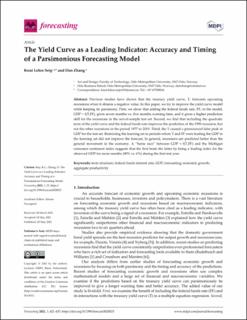| dc.contributor.author | Seip, Knut Lehre | |
| dc.contributor.author | Zhang, Dan | |
| dc.date.accessioned | 2021-06-04T09:43:57Z | |
| dc.date.available | 2021-06-04T09:43:57Z | |
| dc.date.created | 2021-05-24T20:47:34Z | |
| dc.date.issued | 2021-05-28 | |
| dc.identifier.citation | Forecasting. 2021, 3 (2), 421-435). | en_US |
| dc.identifier.issn | 2571-9394 | |
| dc.identifier.uri | https://hdl.handle.net/11250/2757662 | |
| dc.description.abstract | Previous studies have shown that the treasury yield curve, T, forecasts upcoming recessions when it obtains a negative value. In this paper, we try to improve the yield curve model while keeping its parsimony. First, we show that adding the federal funds rate, FF, to the model, GDP = f(T,FF), gives seven months vs. five months warning time, and it gives a higher prediction skill for the recessions in the out-of-sample test set. Second, we find that including the quadratic term of the yield curve and the federal funds rate improves the prediction of the 1990 recession, but not the other recessions in the period 1977 to 2019. Third, the T caused a pronounced false peak in GDP for the test set. Restricting the learning set to periods where T and FF were leading the GDP in the learning set did not improve the forecast. In general, recessions are predicted better than the general movement in the economy. A “horse race” between GDP = f(T,FF) and the Michigan consumer sentiment index suggests that the first beats the latter by being a leading index for the observed GDP for more months (50% vs. 6%) during the first test year. | en_US |
| dc.description.sponsorship | This research was funded by Oslo Metropolitan University. | en_US |
| dc.language.iso | eng | en_US |
| dc.publisher | MDPI | en_US |
| dc.relation.ispartofseries | Forecasting;volume 3, issue 2 | |
| dc.rights | Navngivelse 4.0 Internasjonal | * |
| dc.rights.uri | http://creativecommons.org/licenses/by/4.0/deed.no | * |
| dc.subject | Term structures | en_US |
| dc.subject | Federal funds interest rates | en_US |
| dc.subject | GDP | en_US |
| dc.subject | Forecasting | en_US |
| dc.subject | Economic growths | en_US |
| dc.subject | Aggregate productivity | en_US |
| dc.title | The yield curve as a leading indicator: accuracy and timing of a parsimonious forecasting model | en_US |
| dc.type | Peer reviewed | en_US |
| dc.type | Journal article | en_US |
| dc.description.version | publishedVersion | en_US |
| dc.rights.holder | © 2021 by the authors. | en_US |
| cristin.ispublished | true | |
| cristin.fulltext | original | |
| cristin.qualitycode | 1 | |
| dc.identifier.doi | https://doi.org/10.3390/forecast3020025 | |
| dc.identifier.cristin | 1911546 | |
| dc.source.journal | Forecasting | en_US |
| dc.source.volume | 3 | en_US |
| dc.source.issue | 2 | en_US |
| dc.source.pagenumber | 421-435 | en_US |

